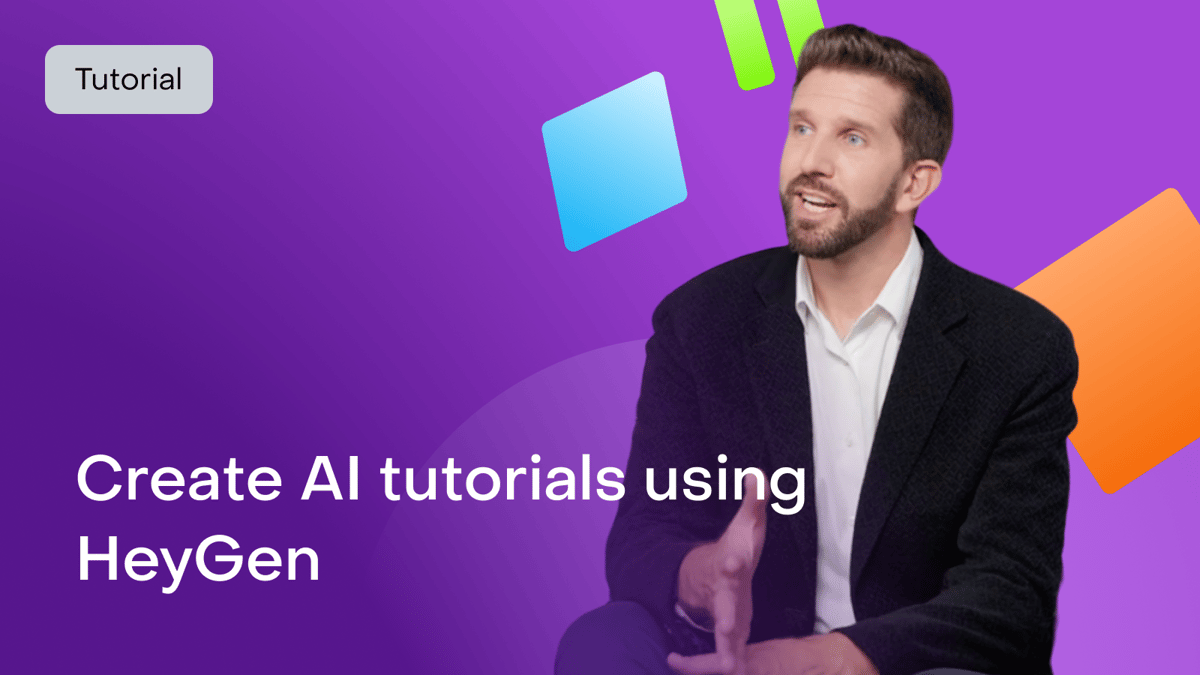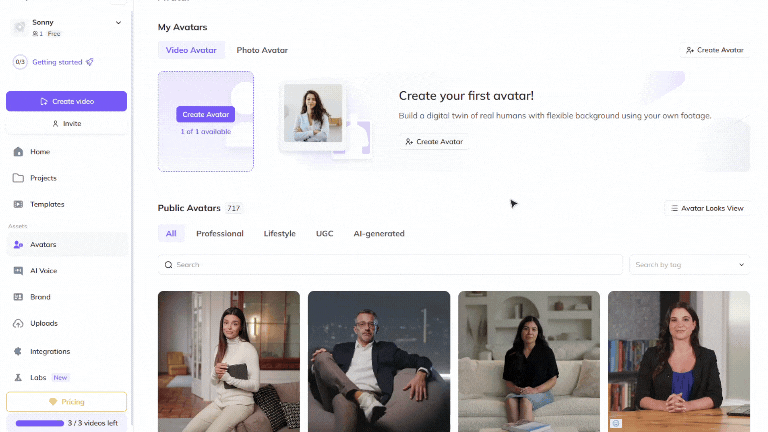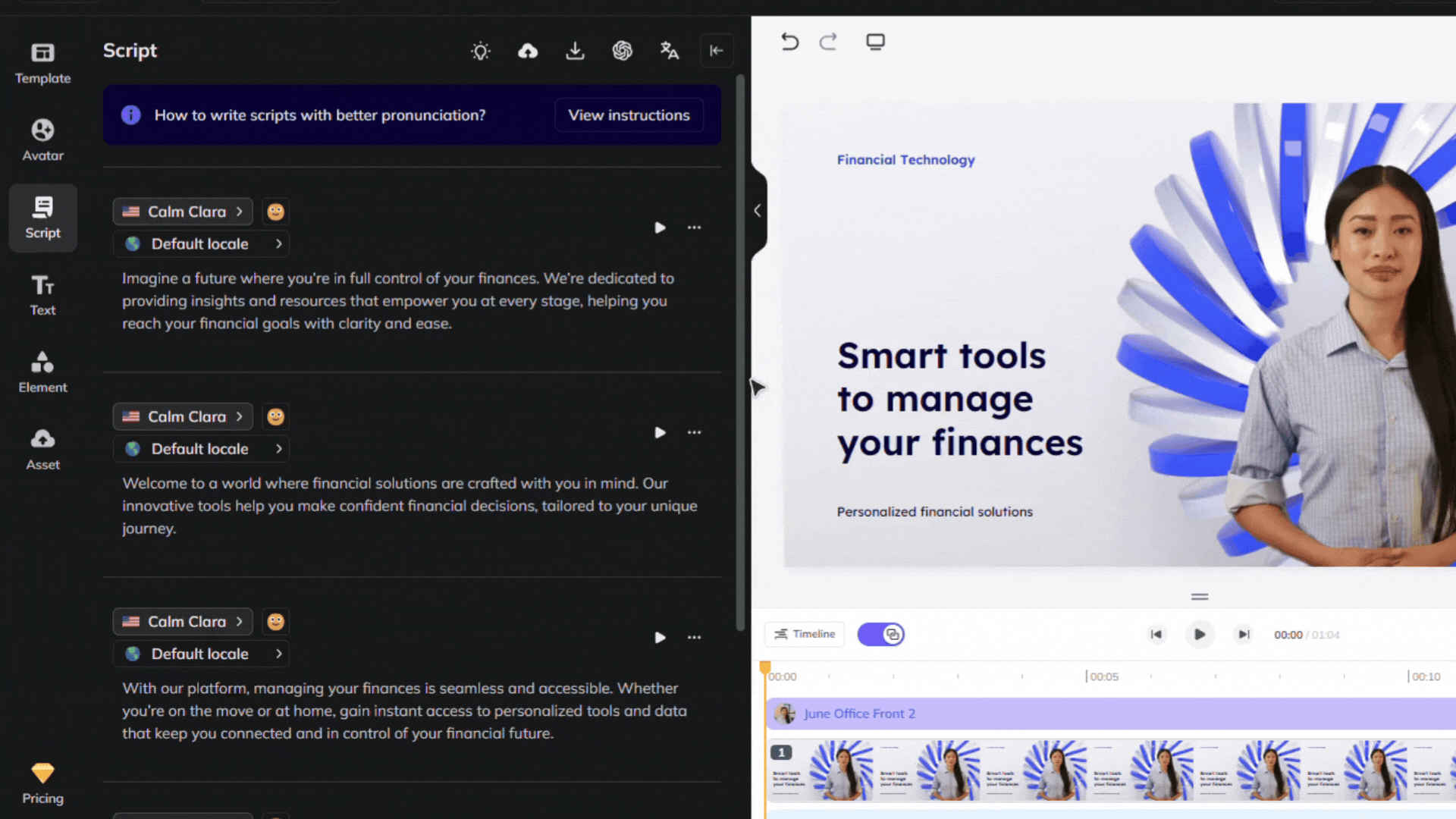Tutorial
March 21, 2024 · Last updated on April 23, 2025
How to use HeyGen for AI tutorials

# Tutorial
-

Explaining artificial intelligence and AI-powered workflows can be complex. With AI-powered, lifelike avatars, you can streamline content creation, maintain consistency, and scale AI education effortlessly. These avatars help content creators, educators, and businesses break down AI concepts, showcase tools, and demonstrate workflows in an engaging and visually compelling way.
Why use avatars for AI tutorials?
Make AI accessible by using avatars with clear speech and dynamic visuals to simplify complex concepts.
Deliver structured guides on AI tools, machine learning concepts, and AI-powered workflows.
Enhance learning with step-by-step demonstrations, animated examples, and interactive visuals.
Increase accessibility by translating and localizing AI tutorials for global audiences.
Scale effortlessly by repurposing AI tutorials for YouTube, online courses, and business training programs.
Step 1: Plan your AI tutorial content
Before creating your video, determine its purpose:
- Guides on using AI tools: Step-by-step tutorials on AI-powered software and platforms.
- Explainer videos on AI concepts: Break down machine learning, automation, and AI fundamentals for learners.
- Content creators showcasing AI workflows: Demonstrate AI-powered content creation, automation, and efficiency tools.
Leverage AI tools like HeyGen’s scriptwriting assistant to craft a structured and engaging script. Not sure where to start? Here’s a sample structure for a 60-second AI tutorial video:
Opening (0-10 seconds) – hook & introduction
Script/Text On-Screen: “AI is changing the way we work and create. In the next 60 seconds, let’s explore how [AI Tool or Concept] can transform your workflow.”
Middle (10-40 seconds) – key AI concept & demonstration
Visual: Animated screen recordings, AI-generated graphics, or step-by-step walkthroughs of AI tools.
Script/Text On-Screen:
- “Step 1: Access the tool and set up your workspace. Here’s how to get started.”
- “Step 2: Input your data or prompt and let AI handle the heavy lifting.”
- “Step 3: Refine and customize your results to match your needs.”
Closing (40-55 seconds) – CTA & encouragement
Visual: Call-to-action text like “Try AI Today” or “Start Automating Your Workflow.”
Voiceover/Text On-Screen:
- “Start leveraging AI in your workflow today and see how it enhances your efficiency.”
- “Follow for more AI tutorials and take your skills to the next level.”
End screen (last 5 seconds)
Visual: AI company or content creator logo, CTA button (e.g., “Watch More” or “Subscribe for AI Tutorials”), and website or social media handle.
Step 2: Choose your AI avatar
HeyGen offers a wide range of avatars for every occasion, along with options for creating custom avatars to bring your AI tutorials to life!

Choose a Public Avatar from HeyGen’s extensive library, featuring 700+ voices compatible with 170+ languages and dialects. Each Public Avatar also comes with multiple Looks, offering a variety of outfits, poses, or backgrounds to match your AI tutorial style.
For a more personalized approach, AI educators and content creators can use HeyGen’s Custom Avatar feature to create a digital twin from their own photos and videos. For the best output, check out our Best Practices for creating AI avatars and voices. You can even customize your avatar’s look with our Generate Looks tool to align with your brand identity.
Want something unique? Explore the option to generate an avatar from text, allowing you to create avatars suited for different AI themes, industries, or futuristic aesthetics.
Step 3: Create different types of AI tutorial videos
Explainer videos, AI workflow demonstrations, and tool guides help audiences understand and apply AI effectively. These structured videos provide actionable insights, hands-on tutorials, and expert guidance.
AI tool guides
Goal: Teach users how to use AI-powered tools and software.
Best format: 60-180 seconds.
Key elements:
- A clear introduction explaining the tool’s purpose and benefits.
- A step-by-step demonstration of how to use the AI tool.
- CTA: Encourage viewers to try the tool and explore its features.
AI explainer videos
Goal: Simplify AI concepts and make machine learning more accessible.
Best format: 90-180 seconds.
Key elements:
- A breakdown of an AI concept using animations and real-world examples.
- Clear explanations of technical terms and AI processes.
- CTA: Invite viewers to learn more through additional content.
AI-powered workflow showcases
Goal: Demonstrate how AI can optimize content creation, automation, and productivity.
Best format: 90-180 seconds.
Key elements:
- A case study or example of AI in action.
- Before-and-after comparisons of AI-powered workflows.
- CTA: Encourage viewers to integrate AI into their own projects.
By creating different types of AI tutorial videos, you can educate, inspire, and empower your audience to leverage AI effectively.
Step 4: Edit and refine
Polish your video to perfection with HeyGen’s intuitive editing tools! HeyGen uses a text-based editor to ensure your scenes, text, and transitions align perfectly with your script.

Review your flow and ensure the avatar’s gestures, voice, and timing align with your script. See our scripting best practices guide for advice on how to ensure accurate pronunciation and pauses. Use our Brand Voice feature to ensure accurate pronunciation across multiple videos and languages!
Step 5: Distribute your video effectively
Once your video is complete, distribute it across multiple platforms:
Upload to YouTube, Udemy, or AI learning platforms to educate a broad audience.
Share on LinkedIn, Twitter, and Reddit to engage AI professionals and tech enthusiasts.
Encourage community discussions by prompting viewers to share their AI experiences, workflows, and questions.
Bonus tips
- Keep tutorials short and actionable: Focus on delivering practical, easy-to-follow AI instructions.
- Use AI-generated visuals and data: Showcase real AI outputs to reinforce concepts.
- Stay updated with AI trends: Technology evolves rapidly—regularly update your content.
- Engage with your audience: Ask viewers for their AI challenges and tailor future content accordingly.
By integrating lifelike avatars into your AI tutorial strategy, you can engage audiences, scale content effortlessly, and make AI education more accessible. AI-powered avatars help simplify complex AI topics, making tutorials more engaging, consistent, and visually compelling. Start creating AI-driven tutorials today and help your audience navigate the future of artificial intelligence!
Like
Comments (0)
Popular
Dive in
Related
46:47
Video
HeyGen for Education: How Educators Use AI Video to Teach Smarter
By Joy Chen • May 1st, 2025 • Views 820
46:47
Video
HeyGen for Education: How Educators Use AI Video to Teach Smarter
By Joy Chen • May 1st, 2025 • Views 820

